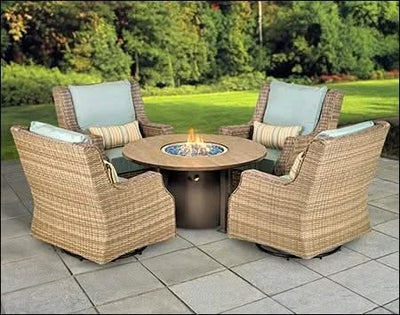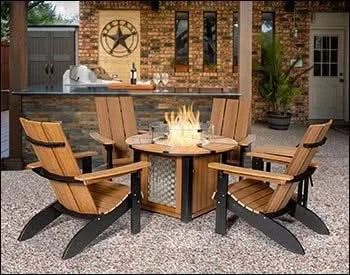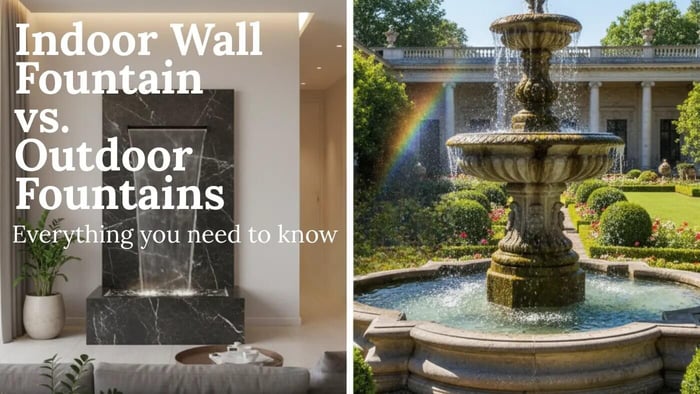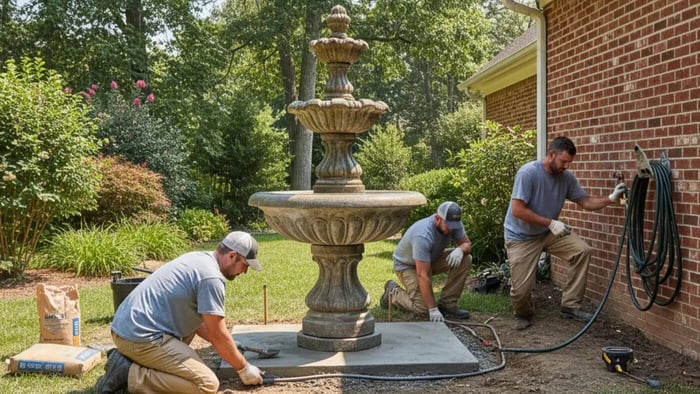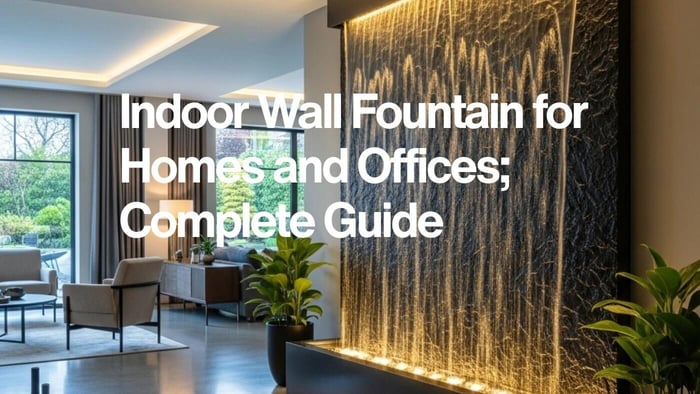Is an indoor wall fountain a good idea for your home? Absolutely! The calming trickle of water, that mesmerizing flow; it’s something we all find incredibly peaceful. Whether you're dreaming of a tranquil oasis in your living room or a stunning centerpiece for your garden, water features bring a special kind of magic.
You've got two main contenders for bringing that magic home: the elegant indoor wall fountain and the majestic outdoor fountain. Both promise peace and beauty, but they go about it in very different ways.
Here at Lux Yard and Homes, we're diving deep into this great "fountain debate" to help you choose. We'll break down everything from how they look and sound, to installation, and how much effort they need.
Ultimately, both types aim to infuse your space with tranquillity and aesthetic appeal. But they're far from identical. Understanding their unique styles, practical differences, and overall impact is crucial. This way, you can pick the perfect water feature that fits seamlessly into your life and makes your home feel just right.
Table of Contents
Is an Indoor Wall Fountain Right for Your Home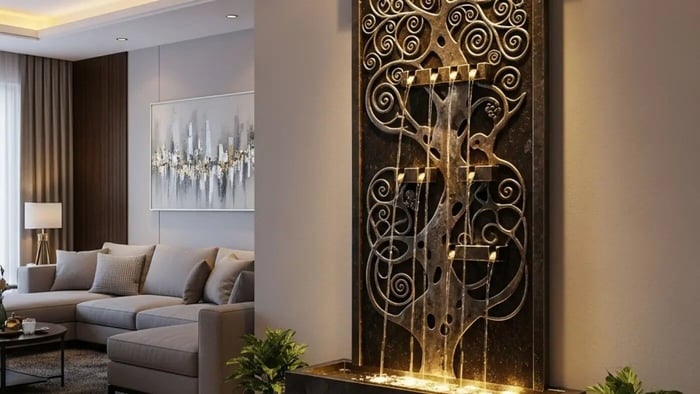
So, what exactly is an indoor wall fountain, and why are so many people falling in love with them? Imagine a beautiful piece of art that not only looks stunning on your wall but also brings the gentle music of flowing water into your living space. That’s essentially what we’re talking about.
These aren't just fancy gadgets; they're self-contained water features, designed specifically to be mounted on or integrated into an interior wall.
Think of them as the sophisticated cousins to the big garden fountains. They’re typically smaller, perfectly sized for indoor rooms, and their whole design philosophy revolves around blending seamlessly with your home's decor. It’s all about creating an elegant statement without taking up precious floor space.
An Indoor Wall Fountain’s Aesthetic & Design Impact
Ever feel like a blank wall just needs something? An indoor wall fountain isn't just a water feature; it's a dynamic, living piece of art that truly elevates your home decor. It's a statement piece that adds immediate visual interest, texture, and depth.
The material of your fountain plays a huge role in its overall look and the vibe it brings to your space:
- Copper offers a warm, rustic, or even industrial chic appeal, subtly developing a unique patina over time.
- Slate delivers a natural, earthy feel, often creating serene, meditative designs perfect for a tranquil corner.
- Marble or polished stone screams luxury and timeless elegance, making a grand statement.
- Glass provides a sleek, modern touch, allowing the water to shimmer and reflect light beautifully, adding a luminous quality.
- Even durable resin can expertly mimic stone or other textures, offering incredible versatility to match any decor style.
Each of these materials helps define the fountain’s personality, guiding it to perfectly complement your vision. Whether you're aiming for a minimalist haven, a cozy bohemian nook, or a traditionally elegant living room.
The Top Benefits of an Indoor Wall Fountain
Beyond its good looks, an indoor wall fountain is a powerhouse of subtle benefits for your well-being and home.
Visual & Spatial Impact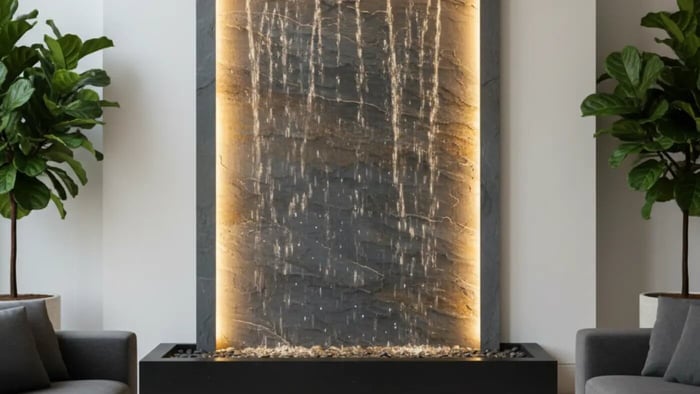
A Visual Focal Point
A well-placed indoor wall fountain instantly draws the eye. It adds incredible texture and depth to a flat wall, breaking up monotony and creating a captivating visual anchor in any room. It's like having a living, breathing painting.
Space Optimization
One of the unsung heroes of the indoor wall fountain is its ability to transform spaces, especially if you're working with limited square footage.
Vertical Appeal
In city apartments or cozier homes, floor space is gold. An indoor wall fountain cleverly uses vertical wall space, turning an otherwise empty area into a stunning feature.
No Footprint, Big Impact
Unlike bulky floor fountains, large sculptures, or even extra furniture, an indoor wall fountain adds a huge decorative punch without taking up any precious real estate on your floor. It’s the ultimate space-saving solution for adding luxury.
Sensory Benefits & Wellness
The Soothing Sound
This is probably the most famous benefit! The gentle burble and trickle of water create a natural "white noise." This isn't just pleasant; it can mask annoying background sounds like distant traffic, noisy neighbors, or even the hum of your appliances. It's perfect for promoting relaxation, reducing stress after a long day, and even aiding in meditation or mindfulness practices. Just close your eyes and listen – pure bliss.
Boosted Air Quality and Humidity
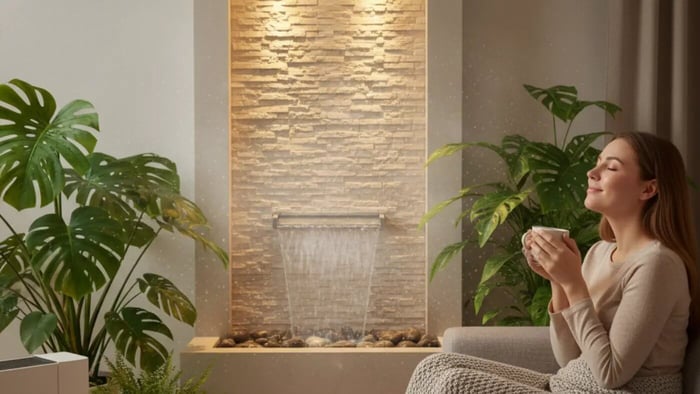
Did you know your fountain can help the air you breathe?
Natural Humidifier
Especially during dry winters when heaters are blasting, or if you live in an arid climate, an indoor wall fountain acts as a natural humidifier. It adds moisture to the air, which can be great for your skin, your houseplants, and even help with dry sinuses.
Negative Ions
Fountains create negative ions as water molecules collide. While the science is complex, many believe negative ions can help clear the air of pollutants and allergens and even improve mood and energy levels. Think of that fresh, clean feeling after a thunderstorm – a small fountain brings a touch of that indoors!
Good Vibrations: Feng Shui Principles
For those interested in balancing energy in the home, an indoor wall fountain is a fantastic tool.
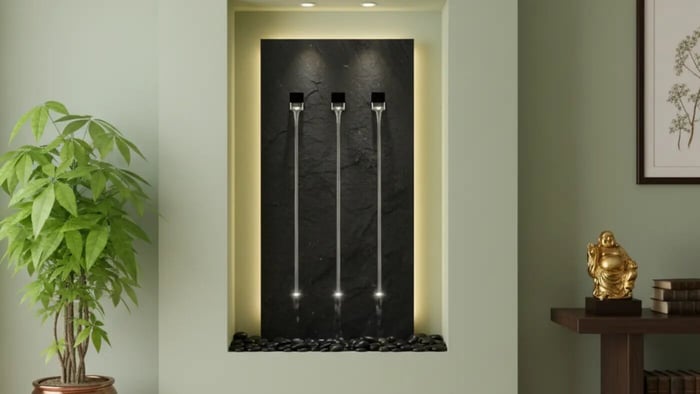
Placement for Prosperity
According to Feng Shui, placing water features correctly can attract positive energy and abundance. Placing it in your "wealth corner" or "career area" can symbolize continuous flow and prosperity.
The Element of Water
Water itself is a powerful symbol of wealth, wisdom, and life's flow. Having this element present and moving in your home is thought to encourage good fortune and calm.
An indoor wall fountain offers a fantastic way to bring continuous beauty, sound, and a sense of calm into your home with manageable upkeep. It's a statement piece that truly gives back, enhancing both your space and your well-being.
Installation & Maintenance for an Indoor Wall Fountain
Okay, so you're convinced an indoor wall fountain is for you. Now, let's talk practicalities. Don't worry, it's often much simpler than you might think!
Installation
Mounting Requirements
Most fountains aren't super heavy, but you'll want to make sure it's securely mounted, ideally into wall studs. Always check the weight specifications and your wall type.
Electrical Access
Since it's self-contained, your fountain just needs a standard electrical outlet nearby to power the pump. No fancy wiring is usually required!
No External Plumbing
This is a huge plus! Unlike some outdoor fountains or built-in features, an indoor wall fountain is a closed system. You just fill it up, and the pump recirculates the water. No need to call a plumber.
DIY vs. Professional
Many smaller to medium-sized wall fountains are perfect for a confident DIYer. For larger, heavier, or more complex designs, or if you're not comfortable with tools, a professional might be a wise choice to ensure it's hung safely and correctly.
Indoor Wall Fountain Maintenance
Keeping your indoor wall fountain sparkling and flowing smoothly is pretty straightforward.
Regular Cleaning
The main thing you'll battle is mineral buildup from hard water (those white crusty bits) and sometimes a bit of algae if the fountain gets direct sunlight. A simple routine of cleaning with a mild cleaner, vinegar, or specialized fountain cleaner will keep it pristine.
Water Level
Water evaporates, especially indoors. You'll need to top off the water every few days or once a week, depending on the fountain size and humidity in your home. It’s like watering a plant, but for serenity!
Pump Care
The pump is the heart of your fountain. Every now and then, give it a quick clean to remove any debris or mineral buildup to ensure it runs efficiently. Blockages can stress the pump.
Filtration
Some fountains come with small filters. Keep these clean or replace them as recommended to keep your water clear.
Distilled Water Trick
Want to dramatically cut down on mineral deposits? Use distilled water! It's a small extra cost but saves a lot of cleaning hassle.
An indoor wall fountain offers a fantastic way to bring continuous beauty, sound, and a sense of calm into your home with manageable upkeep. It's a statement piece that truly gives back, enhancing both your space and your well-being.
The Grandeur of Outdoor Fountains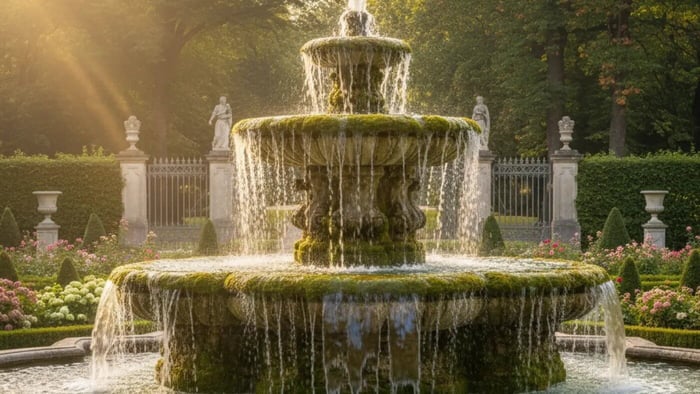
What it is: A water feature designed for exterior environments - gardens, patios, courtyards, entryways. Key characteristics: Larger scale, more robust construction, exposed to natural elements, often integrated into landscaping.
If you’re looking to make a statement, an outdoor fountain is the way to go. These aren’t just decorative pieces; they're substantial features designed to withstand the elements and become a permanent part of your landscape.
They come in a variety of styles, from classic tiered designs and elegant bird baths to modern, sculptural pieces that can look like works of art. They are built to last, with materials like concrete, stone (granite, limestone), bronze, and even durable fiberglass, so they can handle everything Mother Nature throws at them.
Creating a Landscape Masterpiece
An outdoor fountain instantly becomes a focal point in your yard. It’s a dynamic centerpiece that can draw the eye to a specific area of your garden or enhance the grandeur of a main entrance. Think of it as the ultimate landscaping accessory.
Whether you choose a classic statuary fountain for a traditional look or a sleek pondless design for a contemporary feel, it adds a layer of sophistication and purpose to your outdoor space.
Enhancing Ambiance and Wildlife
The sound of an outdoor fountain is a truly sensory experience. The gentle splashing and trickling of water blends perfectly with the sounds of nature, like rustling leaves and birdsong.
This soothing sound can also be a powerful acoustic mask, effectively drowning out unwanted noises like street traffic or distant conversations, creating a more private and enclosed feeling in your yard. Plus, the moving water is a natural magnet for local birds and other small wildlife, turning your yard into a lively, serene retreat.
Sensory and Environmental Benefits
Beyond the aesthetic, outdoor fountains offer practical benefits for your environment.
Misty Coolness
In hot climates, the constant movement and evaporation of water can slightly reduce the ambient temperature in the immediate vicinity, creating a little pocket of refreshing air around the fountain.
Visual Dynamics with Nature
An outdoor fountain is in constant dialogue with its surroundings. The water’s surface reflects sunlight, moonlight, and the surrounding greenery, creating a beautiful, dynamic display. When a breeze picks up, the water flow changes, adding another layer of visual interest. You can even add lights to the fountain and surrounding plants for a dramatic effect at night.
Installation and Maintenance Considerations for Outdoor Fountains
The size and scale of outdoor fountains mean installation and maintenance are more involved.
Installation
This isn’t usually a quick DIY project. Heavy fountains require site preparation, including levelling and a solid foundation to prevent them from shifting. You'll need outdoor-rated wiring and a GFCI outlet for safety, and for some larger fountains, the wiring may need to be trenched underground.
While many fountains are self-contained and recirculate their water, you will need a nearby hose for refills. For these reasons, professional installation is often recommended to ensure everything is set up safely and correctly.
Maintenance
Since they're exposed to the elements, outdoor fountains require more robust cleaning. You’ll be dealing with leaves, dirt, and insects. Algae can also be an issue, so you may need to use algaecides or scrub the fountain regularly.
In colder climates, winterization is crucial—you'll need to drain the fountain, cover it, and bring the pump indoors to protect it from freezing. You'll also want to use a water treatment to prevent hard water stains and calcium buildup. And over time, UV rays can cause components like hoses and seals to degrade, so it's a good idea to check them periodically.
An outdoor fountain is a grand investment that brings life, sound, and a sense of permanence to your landscape. It's a decision to create a destination, a personal retreat right in your backyard.
Side-by-Side Comparison: Indoor Wall Fountain vs. Outdoor Fountains
Choosing the right fountain for your space comes down to understanding the key differences. While both bring the beauty of water to your home, they are built for entirely different purposes. Here's a side-by-side look at how indoor and outdoor fountains stack up.
Key Differentiating Factors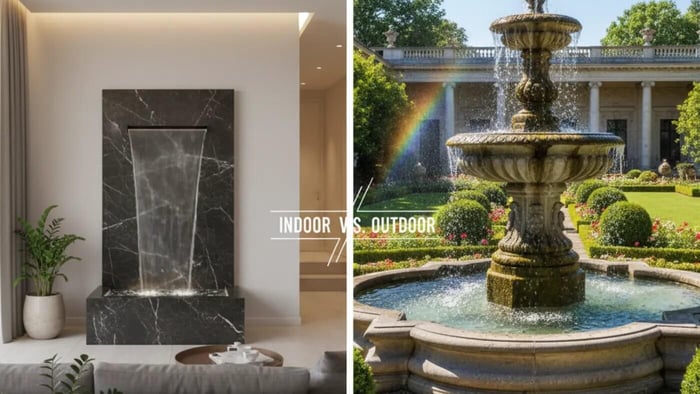
In essence, the choice between an indoor and outdoor fountain is a decision about purpose. An indoor fountain is an accent, a functional piece of decor that improves your home's ambiance and atmosphere. An outdoor fountain is a statement; a permanent fixture designed to withstand the elements and define your landscape.
Making Your Choice: Which Fountain is Right for You?
Now that you have a clearer picture of the differences, it's time to decide what works best for you. The "best" fountain isn't a one-size-fits-all answer; it's the one that perfectly fits your space, your lifestyle, and your personal goals for your home.
Consider Your Space
Indoor Wall Fountain
If you're working with limited floor space or a small apartment, an indoor wall fountain is a genius solution. It adds luxury and ambiance without taking up any precious real estate. It's the perfect choice when you want to create a quiet, meditative space inside.
Outdoor Fountain
Do you have a large garden, a spacious patio, or a courtyard? An outdoor fountain is your chance to make a grand statement and truly enhance your landscape. Go this route if you want to invite the sounds of nature and local wildlife into your environment.
Consider Your Lifestyle
- Maintenance: Be honest about your commitment. While both fountains require some care, an outdoor fountain will demand more of your time, especially with seasonal cleaning and winterization. If you prefer a "set it and forget it" approach (with occasional topping up), an indoor fountain is a better fit.
- Budget: Think about both the initial cost and the ongoing costs. Large outdoor fountains can have higher upfront costs for the feature itself and for professional installation, while indoor fountains are generally more affordable and have lower running costs.
- Design: What aesthetic are you trying to achieve? An indoor fountain is all about integrating a refined, artistic focal point into your existing decor, while an outdoor fountain is about defining and elevating your landscape architecture.
The Hybrid Approach
It's also worth noting that some fountains blur the lines. Smaller, tabletop-style fountains are versatile enough to work in sheltered outdoor areas, like a covered patio or a balcony. On the other hand, a larger, statuary-style fountain might be placed in a grand, vaulted interior space if the design allows for it.
Ultimately, the right choice for you depends entirely on what you want to achieve. Are you looking for a personal sanctuary in your home or a grand, living masterpiece for your yard? The best fountain is the one that brings you the most tranquility and beauty.
An indoor wall fountain offers serenity and style within your living space, serving as a tranquil, space-saving work of art that enhances your indoor air and sound quality.
An outdoor fountain, on the other hand, makes a grand statement in your landscape, creating a natural oasis that attracts wildlife and provides a peaceful retreat. While their scale and function differ, both share a common goal: bringing the calming, life-giving power of water into your life.
The perfect fountain for you is out there—it's the one that helps you create your own personal sanctuary. Explore our diverse range of fountains today to find your perfect match.
FAQs
Is it good to have a water fountain inside the house?
Yes, absolutely. Having an indoor water fountain is a fantastic idea for your home, offering a wide range of benefits that go far beyond simple decor. They are a multi-sensory addition that can significantly improve your well-being and home environment.
The most famous benefit is the soothing sound of flowing water. The gentle, consistent trickle creates a natural "white noise" that is incredibly effective at masking distracting sounds from outside or other rooms. This promotes a feeling of peace and quiet, helping you relax, meditate, or simply de-stress after a long day.
Additionally, an indoor fountain acts as a natural air humidifier. This is especially beneficial in dry climates or during winter months when indoor heaters are running, as it adds moisture back into the air. This can help with dry skin, relieve irritated sinuses, and keep your houseplants healthy. Many also believe that the moving water releases negative ions, which may help to purify the air of pollutants and allergens.
Beyond the sensory benefits, an indoor fountain is a beautiful and unique design statement. It acts as a captivating visual focal point, adding texture and a dynamic, living element to any flat wall or empty corner. With a wide variety of styles and materials available, you can easily find one that perfectly complements your home's aesthetic, from rustic and natural to sleek and modern.
Are indoor water fountains consuming a lot of electricity?
No, you'll be happy to know that indoor water fountains are surprisingly energy-efficient and consume very little electricity. This is one of their major benefits!
Most indoor fountains operate using a small, self-contained electric pump that recirculates the water. These pumps are designed for continuous, low-power operation. Typically, an indoor fountain pump uses less electricity than a standard light bulb – often just 5 to 15 watts. To put that into perspective, running a small fountain 24/7 for an entire month would likely add only a few dollars to your electricity bill, depending on local electricity rates.
So, you can enjoy the calming sounds and aesthetic beauty of a water feature in your home without worrying about a significant jump in your energy costs. They are designed to be an affordable and sustainable way to enhance your living space.
Where should a fountain be placed on a patio?
Placing a fountain on your patio isn't just about finding an empty spot; it's about maximizing its impact on ambiance, sound, and visual appeal. Here's how to choose the perfect location:
Consider it a Focal Point:
Visibility: Place it where it can be easily seen and enjoyed from your main seating areas on the patio, or even from inside your home looking out. It should naturally draw the eye.
Background: Consider what's behind the fountain. A solid wall, lush greenery, or an attractive fence makes for a much better backdrop than a cluttered corner or an unattractive view.
Optimize for Sound:
Proximity to Seating: To truly enjoy the soothing sounds, place the fountain close enough to where you typically sit and relax. The closer it is, the more effectively it can mask unwanted background noise.
Acoustic Environment: Think about how the sound will travel. Avoid placing it directly next to a noisy air conditioning unit or a high-traffic area if its calming effect will be lost.
Practical Considerations:
Electrical Access: Most fountains need to be plugged in. Ensure there's a nearby outdoor-rated GFCI (Ground-Fault Circuit Interrupter) outlet for safety, or plan for professional electrical installation. Avoid long extension cords if possible.
Level Surface: The fountain needs a stable, level surface. For heavier fountains, you might need to prepare a reinforced pad or foundation to prevent shifting or cracking over time.
Splash Zone: All fountains splash a little. Consider how far the water might spray. Avoid placing it too close to sensitive outdoor furniture, delicate plants, or areas where water accumulation could become a slip hazard.
Sunlight & Debris: If possible, place it where it's not constantly bombarded by falling leaves or direct, intense sunlight all day, which can accelerate algae growth and water evaporation. However, a little sun can highlight the water beautifully.
Refill Access: While most patio fountains are self-contained, you'll need to refill them periodically. Ensure you have easy access with a hose.
By thinking through these points, you can choose a spot that not only looks fantastic but also enhances your entire patio experience.
Do outdoor water fountains attract mosquitoes?
This is a common and valid concern for anyone considering an outdoor water feature! The good news is that outdoor water fountains are generally not a breeding ground for mosquitoes if properly maintained.

